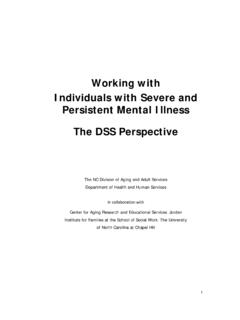Transcription of Process Safety Management - Occupational Safety and …
1 Process Department of LaborOccupational Safety and Health AdministrationOSHA 31322000 (Reprinted)This informational booklet isintended to provide a generic,non-exhaustive overview of aparticular standards-related publication does not itselfalter or determine complianceresponsibilities, which are setforth in OSHA standards them-selves and the OccupationalSafety and Health Act. Moreover,because interpretations andenforcement policy may changeover time, for additional guidanceon OSHA compliance require-ments, the reader should consultcurrent and administrative inter-pretations and decisions bythe Occupational Safety andHealth Review Commissionand the contained in this publica-tion is in the public domain andmay be reproduced, fully orpartially, without permissionof the Federal credit is requested butnot information will be madeavailable to sensory impairedindividuals upon phone: (202) 693-1999 Process Department of LaborAlexis M.
2 Herman, SecretaryOccupational Safety and Health AdministrationCharles N. Jeffress, Assistant SecretaryOSHA 31322000 (Reprinted)ContentsContentsiiiThe 1 How the Standard 5 Process Safety 7 Process Hazard 9 Operating 12 Employee 15 Initial Training .. 15 Refresher Training .. 15 Training Documentation .. 16 Application .. 16 Employer Responsibilities .. 16 Contract Employer Responsibilities .. 16 Pre-Startup Safety 18 Mechanical 19 Hot Work 21 Management of 22 Incident 23 Emergency Planning and 24 Compliance 25 Trade 26 Part 1910- Occupational Safety and Health 27 Explosives and Blasting 27 Process Safety Management of Highly Hazardous 28 Appendix A - List of Highly Hazardous Chemicals, Toxics and Reactives (Mandatory).
3 42 Appendix B - Block Flow Diagram and Simplified Process Flow Diagram (Nonmandatory).. 46 OSHA Consultation 48 States With Approved 50 Related 54 The ProblemThe Problem1 Unexpected releases of toxic, reactive, or flammable liquids andgases in processes involving highly hazardous chemicals have beenreported for many years. Incidents continue to occur in variousindustries that use highly hazardous chemicals which may be toxic,reactive, flammable, or explosive, or may exhibit a combination ofthese properties. Regardless of the industry that uses these highlyhazardous chemicals, there is a potential for an accidental release anytime they are not properly controlled.
4 This, in turn, creates thepossibility of major disasters include the 1984 Bhopal, India, incidentresulting in more than 2,000 deaths; the October 1989 PhillipsPetroleum Company, Pasadena, TX, incident resulting in 23 deathsand 132 injuries; the July 1990 BASF, Cincinnati, OH, incidentresulting in 2 deaths, and the May 1991 IMC, Sterlington, LA,incident resulting in 8 deaths and 128 these major disasters involving highly hazardouschemicals drew national attention to the potential for major catastro-phes, the public record is replete with information concerning manyother less notable releases of highly hazardous chemicals.
5 Hazard-ous chemical releases continue to pose a significant threat to employ-ees and provide impetus, internationally and nationally, for authori-ties to develop or consider developing legislation and regulations toeliminate or minimize the potential for such July 17, 1990, OSHA published in the Federal Register (55 FR29150) a proposed standard, Process Safety Management ofHighly Hazardous Chemicals containing requirements for themanagement of hazards associated with processes using highlyhazardous chemicals to help assure safe and healthful s proposed standard emphasized the Management ofhazards associated with highly hazardous chemicals and establisheda comprehensive Management program that integrated technologies,procedures.
6 And Management notice of proposed rulemaking invited comments on anyaspect of the proposed standard for Process Safety Management ofhighly hazardous chemicals and announced the scheduling of ahearing to begin on November 27, 1990, in Washington, November 1, 1990, OSHA published a Federal Register notice(55 FR 46074) scheduling a second hearing to begin on February 26, Process Safety Management21991, in Houston, TX, enumerating additional issues, and extendingthe written comment period until January 22, hearings on the proposed standard were held in Washington,DC, from November 27, 1990, through December 4, 1990, and inHouston, TX, from February 26, 1991, through March 7, 1991.
7 TheAdministrative Law Judge presiding at the hearings allowed partici-pants to submit post-hearing comments until May 6, 1991, and filepost-hearing briefs until June 5, 1991. OSHA received more than175 comments in response to the notice of proposed rulemaking. Inaddition to these comments, the hearings resulted in almost 4,000pages of testimony and almost 60 post-hearing comments and readers convenience, this publication includes, as an appendix,the full text of the final OSHA standard issued in the Federal Regis-ter on February 24, 1992, including the list of covered chemicals andthreshold plan States, approved under section 18(b) of the Occupa-tional Safety and Health Act of 1970 (see list on page 36) must adoptstandards and enforce requirements which are at least as effective asFederal requirements.
8 There are currently 25 State plan States; 23covering private and public (State and local government) sectors andtwo covering public sector only. Plan States must adopt comparablestandards to the Federal within six months of a Federal standard four months after the publication of OSHA sproposed standard for Process Safety Management of highly hazard-ous chemicals, the Clean Air Act Amendments (CAAA) wereenacted into law (November 15, 1990). Section 304 of the CAAA requires that the Secretary of Labor, in coordination with the Admin-istrator of the Environmental Protection Agency (EPA), promulgate,pursuant to the Occupational Safety and Heath Act of 1970, achemical Process Safety standard to prevent accidental releases ofchemicals that could pose a threat to CAAA requires that the standard include a list of highlyhazardous chemicals which includes toxic, flammable, highlyreactive, and explosive substances.
9 The CAAA also specifiedminimum elements that the OSHA standard must require employersto do, as follows:3 The Problem(1) Develop and maintain written Safety information identifyingworkplace chemical and Process hazards, equipment used in theprocesses, and technology used in the processes;(2) Perform a workplace hazard assessment, including, as appro-priate, identification of potential sources of accidental releases,identification of any previous release within the facility that had apotential for catastrophic consequences in the workplace, estimationof workplace effects of a range of releases, and estimation of thehealth and Safety effects of such a range on employees;(3) Consult with employees and their representatives on thedevelopment and conduct of hazard assessments and the develop-ment of chemical accident prevention plans and provide access tothese and other records required under the standard.
10 (4) Establish a system to respond to the workplace hazard assess-ment findings, which shall address prevention, mitigation, andemergency responses;(5) Review periodically the workplace hazard assessment andresponse system;(6) Develop and implement written operating procedures for thechemical processes, including procedures for each operating phase,operating limitations, and Safety and health considerations;(7) Provide written Safety and operating information for employ-ees and employee training in operating procedures, by emphasizinghazards and safe practices that must be developed and made avail-able;(8) Ensure contractors and contract employees are provided withappropriate information and training;(9) Train and educate employees and contractors in emergencyresponse procedures in a manner as comprehensive and effective asthat required by the regulation promulgated pursuant to section126(d) of the Superfund Amendments and Reauthorization Act;(10) Establish a quality assurance program to ensure that initialprocess-related equipment, maintenance materials, and spare partsare fabricated and installed consistent with design specifications.

















